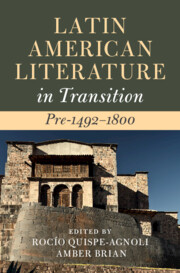Book contents
- Latin American Literature in Transition Pre-1492–1800
- Latin American Literature in Transition
- Latin American Literature in Transition Pre-1492–1800
- Copyright page
- Dedication
- Contents
- Figures
- Contributors
- Acknowledgments
- Introduction Dwelling in Transitions
- Part I Land, Space, Territory
- Part II Body
- Chapter 5 The Health of the Soul: Religious Guidance and Medical Practice in Early Colonial Mexico
- Chapter 6 Viceroy Valero’s Heart: A Traveling Relic and an Embodied Metaphor in Transit to the Indies
- Chapter 7 Humoralism and Colonial Subjugation: Indians and Medical Knowledge in the Sixteenth and Seventeenth Centuries
- Chapter 8 Assaulted Bodies: The Case of Two Enslaved Black Women in the Port City of Santa María de los Ángeles de Buenos Aires, 1772–1778
- Part III Belief Systems
- Part IV Literacies
- Part V Languages
- Part VI Identities
- Index
- References
Chapter 7 - Humoralism and Colonial Subjugation: Indians and Medical Knowledge in the Sixteenth and Seventeenth Centuries
from Part II - Body
Published online by Cambridge University Press: 25 November 2022
- Latin American Literature in Transition Pre-1492–1800
- Latin American Literature in Transition
- Latin American Literature in Transition Pre-1492–1800
- Copyright page
- Dedication
- Contents
- Figures
- Contributors
- Acknowledgments
- Introduction Dwelling in Transitions
- Part I Land, Space, Territory
- Part II Body
- Chapter 5 The Health of the Soul: Religious Guidance and Medical Practice in Early Colonial Mexico
- Chapter 6 Viceroy Valero’s Heart: A Traveling Relic and an Embodied Metaphor in Transit to the Indies
- Chapter 7 Humoralism and Colonial Subjugation: Indians and Medical Knowledge in the Sixteenth and Seventeenth Centuries
- Chapter 8 Assaulted Bodies: The Case of Two Enslaved Black Women in the Port City of Santa María de los Ángeles de Buenos Aires, 1772–1778
- Part III Belief Systems
- Part IV Literacies
- Part V Languages
- Part VI Identities
- Index
- References
Summary
From the Iberian colonization on, the American Indians were understood based on their skin color and the place where they were living. They were imputed a corporal condition and/or a complexio linked to the preponderance of the melancholic and phlegmatic ‘humor’ which expressed a kind of specific morality and behavior according to medical discourse of the sixteenth through the eighteenth centuries. This chapter analyzes how these medical assessments were transferred to the American Indians with a high degree of generalizing essentialism in order to naturalize a condition of permanent servitude. This knowledge transfer used to describe them, implied a series of strategic analogies and correspondences among the generalized significations and representations of complex melancholy on the individuals in the Old World and the observed practices and behaviors of the Natives of the New World.
Keywords
- Type
- Chapter
- Information
- Latin American Literature in Transition Pre-1492–1800 , pp. 107 - 120Publisher: Cambridge University PressPrint publication year: 2022



